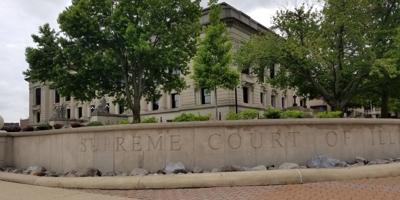
Illinois Supreme Court, Springfield, Ill.
SPRINGFIELD, ILLINOIS - The Illinois Supreme Court has overturned a state appeals court, agreeing the lower court was wrong to find a teen whose mother was excluded from the courtroom during parts of his murder trial could use that situation as a basis for seeking a new trial.
The charges against Matthew Smith date to August 2012 when police arrested him outside the Press Box bar in Harvey following a fatal shooting. He was 16 at the time. According to court records, during pretrial discussions both Smith’s defense team and state prosecutors requested all witnesses be excluded from the courtroom, but Smith’s lawyers sought an exception for his mother, whom prosecutors had listed as a possible witness.
Prosecutors agreed the mother was an unlikely witness, and the defense argued an interaction between Smith and his mother before he decided to speak with police officers was recorded so she wouldn’t need to be called for additional testimony. However, the judge ruled her excluded from the courtroom until prosecutors asserted she would no longer be deemed a potential witness. Among the aspects she couldn’t observe were jury selection, opening statements and the state’s primary presentation of its case.
After a jury found Smith guilty of first-degree murder, he asked for a new trial, claiming the exclusion of his mother constituted a denial of his right to a public trial. He raised other considers about suspect lineups, testimony, a picture used as evidence and closing statements, but an appeals panel found the first issue dispositive and remanded the case. Prosecutors then asked the Supreme Court to review the proceedings.
Justice Mary Kay O’Brien wrote the unanimous opinion, filed Oct. 2.
“Defendant’s right to a public trial was not implicated by the trial court’s exclusion of his mother from the courtroom,” O’Brien wrote. “At no time did the trial court close the courtroom. Although defendant’s mother was temporarily excluded, the courtroom remained open to the public, including other family members, spectators and the media. In fact, defendant’s other family members were in attendance throughout the trial.”
Excluding potential witnesses from a courtroom is common practice, the court said, as judges have the authority to restrict attendance without violating the Sixth Amendment. The court reversed the appellate ruling on that decision but proceeded to address the remaining issues Smith raised on appeal because that panel had analyzed the contentions of error in belief they would recur on remand.
O’Brien said the Supreme Court agreed discrepancies in a second police lineup — Smith said the fillers were too old and didn’t have distinctive hairstyles, while also insisting he shouldn’t have been wearing his own red-and-white shirt as eyewitnesses had already flagged it as notable — didn’t combine to make the lineup unduly suggestive.
Quoting the trial judge, O’Brien said the fillers didn’t “look much older than the defendant” and that his mohawk was “not very pronounced. It’s not spiky or dyed a different color.” She explained lineups are suggestive when a defendant can show specific police activity intended to spotlight a certain suspect, but there is no evidence of such conduct regarding Smith.
All three witnesses who identified Smith in the second lineup testified he had a mohawk and wore a red and white shirt. A different witness who identified him in the first lineup, when Smith was wearing only a white tank top, “also testified the shooter wore a red shirt,” O’Brien wrote.
The appellate panel found the state violated a discovery because a, Illinois State Police gunshot residue expert contradicted the report she provided before the trial. Both parties agree she “concluded in her report that her analysis did not reveal gunshot residue on (Smith) sufficient to establish that he discharged a firearm,” O’Brien wrote, but “she then retreated from that conclusion by testifying about the standards other laboratories use.”
O’Brien said the Supreme Court agreed with the appellate finding that this did constitute a discovery violation, but also found that error was not enough to warrant reversing the verdict because Smith couldn’t establish how the violation prejudiced the jury against him.
“The evidence against defendant was overwhelming: he admitted he was at the Press Box wearing the red and white shirt the night of the shooting, four eyewitnesses identified him in lineups, he removed his red and white shirt after the shooting, and he fled from the Press Box and from the officers after his vehicle was stopped,” O’Brien wrote, revisiting the expert’s “ultimate conclusion that the gunshot residue analysis indicated that defendant may not have discharged a firearm.”
Regarding a photograph the trial judge supplied to the jury after it wasn’t presented at the trial, O’Brien said Smith’s argument on appeal was that the image placed him at the bar the night of the shooting, but when he sought to exclude the picture before the trial the sticking point was allegations he and other men were flashing gang signs. She further noted Smith’s lawyers said the picture was taken at the club, that the club was the site of the shooting and that Smith was wearing the red and white shirt inside the club and only reversed course when the jury asked to see the picture.
“The trial court rejected (Smith’s) argument that the prejudice from the photograph outweighed its probative value and found the photograph admissible as defendant’s personal property,” O’Brien wrote. “Had (Smith) not made the admissions the photograph was taken in the Press Box the night of the shooting, the state could have secured testimony to establish that it was. Because of the defendant’s admissions, the state had no need to present any testimony on when the photograph was taken. Considering the above facts, we cannot say that the trial court abused its discretion in permitting the jury to view the admitted photograph of defendant in the bar.”
Finally, regarding Smith’s challenge to part of prosecutors’ closing statements, the court agreed it was improper for an attorney to say “in order for you to find him not guilty, you have to find that what they’re saying is that all for people life, lied to your face. That is what you have to find.” However, O’Brien noted, the larger record show the state’s lawyers repeatedly stated Smith had no burden of proof — including just before the challenged comment. She further explained the trial judge addressed the jury about the closing arguments not being evidence, restated the presumption of innocence and underscored the state’s responsibility to prove its allegations.
One single comment, the court said, was cured by the broader context, and “it is unlikely (Smith) would have been acquitted had the state not made the improper comment.”
A second comment — “The only way this is a whodunit is if you ignore the testimony that you have, if you find the four people who were in front of you liars” — was not clear or obvious error, O’Brien said, because it didn’t shift the burden of proof.
“In coming to this conclusion, we note that the appellate court curiously chose to review only two of the several closing argument comments that (Smith) alleged were improper on direct appeal,” O’Brien wrote. “Accordingly, we must remand this case to the appellate court for it to consider only those issues that were not addressed in its decision appealed to this court.”


